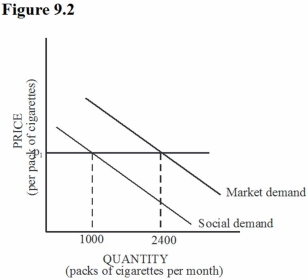A) $5
B) $7
C) $10
D) $50
Correct Answer

verified
Correct Answer
verified
Multiple Choice
All of the following are macro failures that justify government intervention except for:
A) High unemployment.
B) A rising price level.
C) A decline in the production capacity.
D) Inequitable distribution of output.
Correct Answer

verified
Correct Answer
verified
Multiple Choice
Figure 9.2:  -In Figure 9.2,the market demand curve is above the social demand curve because:
-In Figure 9.2,the market demand curve is above the social demand curve because:
A) There are internal costs associated with cigarette smoking.
B) There are free riders associated with cigarette smoking.
C) The external costs of cigarette smoking are being passed on to those who do not smoke.
D) Positive externalities are being passed on to those who do not smoke.
Correct Answer

verified
Correct Answer
verified
Multiple Choice
Externalities are a type of market failure because:
A) Buyers do not have complete information about the product.
B) Producers have too much power.
C) Third parties bears the costs or benefits of a market activity.
D) Goods and services are not distributed fairly.
Correct Answer

verified
Correct Answer
verified
Multiple Choice
The most important motivation for producers is the desire to:
A) Minimize external costs.
B) Minimize social costs above private costs.
C) Maximize economic profits.
D) Maximize social benefits and private revenues at the same time.
Correct Answer

verified
Correct Answer
verified
Multiple Choice
If external benefits exist:
A) The market will overproduce the good.
B) Private demand will exceed social demand.
C) Market demand will understate social demand.
D) The market will generate the optimal outcome.
Correct Answer

verified
Correct Answer
verified
Multiple Choice
After the government filed its antitrust case,Microsoft:
A) Ignored the power of antitrust policy.
B) became even bolder in abusing its market power.
C) Won its case in the courts and continued using predatory pricing.
D) Changed some of its exclusionary licensing practices.
Correct Answer

verified
Correct Answer
verified
Multiple Choice
Social demand is equal to market:
A) Demand plus externalities.
B) Supply plus market demand.
C) Demand minus externalities.
D) Demand multiplied by externalities.
Correct Answer

verified
Correct Answer
verified
Multiple Choice
The market under produces public goods because:
A) The government is mandated to produce public goods.
B) People do not want public goods as much as private goods.
C) People are less willing to pay for public goods than for private goods.
D) Of concerns about equity.
Correct Answer

verified
Correct Answer
verified
Multiple Choice
In order to reduce pollution,the government can use all of the following except:
A) Income transfers.
B) Emissions charges.
C) Forced recycling.
D) Regulatory standards.
Correct Answer

verified
Correct Answer
verified
Multiple Choice
Whenever there is a divergence between social costs and market costs,the result is:
A) Market power.
B) Market failure.
C) Maximized social welfare.
D) A higher minimum wage.
Correct Answer

verified
Correct Answer
verified
Multiple Choice
Market failure establishes a basis for:
A) Market power.
B) Externalities.
C) Government intervention.
D) Private goods.
Correct Answer

verified
Correct Answer
verified
Multiple Choice
The distinction between public goods and private goods is based on:
A) Government regulation.
B) Who produces the goods.
C) How much the goods cost.
D) The link between payment and consumption.
Correct Answer

verified
Correct Answer
verified
Multiple Choice
A private good is a good that:
A) Is financed by private dollars instead of taxes.
B) Can be jointly consumed.
C) Can be denied to those who do not pay for it.
D) Consumers use privately in their homes.
Correct Answer

verified
Correct Answer
verified
Multiple Choice
If market prices and sales are used to signal desired output,then the optimal mix of output is determined by:
A) The market mechanism.
B) The political process.
C) The Federal Reserve System.
D) Government intervention.
Correct Answer

verified
Correct Answer
verified
Multiple Choice
Noise generated by an airport best illustrates:
A) An inequity.
B) An externality.
C) Market power.
D) Overproduction of private goods.
Correct Answer

verified
Correct Answer
verified
True/False
The government uses taxes and transfers to redistribute income more fairly.
Correct Answer

verified
Correct Answer
verified
Multiple Choice
External costs are equal to the difference between:
A) Social costs and private costs.
B) Marginal benefits and marginal costs.
C) Average benefits and average costs.
D) Marginal social benefits and marginal social costs.
Correct Answer

verified
Correct Answer
verified
Multiple Choice
Private costs are identified as:
A) Costs borne by a third party as a result of polluting activities by producers.
B) The difference between the social and public costs of a market activity.
C) The costs of an economic activity borne directly by the immediate producer or consumer.
D) Being greater,in general,than social costs.
Correct Answer

verified
Correct Answer
verified
True/False
Firms that are able to push part of their costs onto society by polluting will produce more output than society desires.
Correct Answer

verified
Correct Answer
verified
Showing 81 - 100 of 150
Related Exams